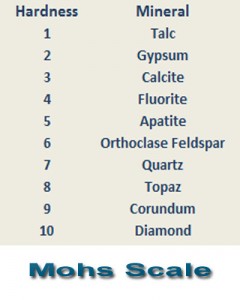There are some tools and concepts that all jewelry makers, including pearl and bead stringers, should be familiar with. One of these is the Mohs scale of mineral hardness.
The Mohs scale is named for Frederick Mohs, a German geologist, who developed it in the early nineteenth century. It tells us how hard a mineral is and how resistant it is to scratching by another mineral.
It’s important not to confuse hardness – a gemstone’s ability to resist scratching – with toughness which refers to a gemstone’s ability to resist fracturing.
The Mohs scale takes ten minerals, from talc through diamonds, and assigns them a number which reflects their hardness. (The minerals selected by Mohs back in the 19th century were somewhat arbitrary. He selected them because they were widely available.)
Talc has a hardness of one and is the softest mineral on the Mohs scale. Talc is so soft it can be scratched with a fingernail.
Diamond has a hardness of ten and is the hardest mineral on the Mohs scale. A diamond can be scratched by another diamond, but it cannot be scratched by corundum (ruby or sapphire) which is a nine on the Mohs scale.
It’s important to understand that the Mohs scale is a relative scale, not proportional. A mineral with a number four on the Mohs scale is not twice as soft as a mineral with a number eight. In another example, diamond which has a number 10 on the Mohs scale is four times harder than corundum which is a number nine.
The Mohs scale uses only 10 minerals for reference, however, all known minerals have been assigned a number on the scale, so they are easy to look up.
So why is this concept so important? A mineral’s ability to resist scratching can help us determine how it should be used in jewelry. Fluorite, for example, is a lovely gemstone that is available in many colors. But fluorite has a Mohs hardness of four. This means it’s soft and vulnerable to scratching. This tells jewelry makers that fluorite should not be used in rings which commonly receive a lot of wear and tear. Instead the gemstone should be used in necklaces, brooches, pendants and earrings, that is, in jewelry which generally doesn’t get knocked around the way rings (and bracelets) do. And, if you’re using fluorite beads, it’s critical that they are knotted. The knots will prevent the fluorite from rubbing against each other and scratching.
Related to the concept of hardness is the concept of toughness. This refers to a mineral’s ability to withstand fracturing. Diamonds, for example, are ten on a Mohs scale, but they are vulnerable to fracturing, chipping and breakage. In another example, emeralds are a 7.5-8 on a Mohs scale, but they are susceptible to breakage because they generally have inclusions. (This is why emeralds are often made into cocktail rings, but rarely into engagement rings.)
When you are making jewelry, especially when you are making jewelry with gemstones you are unfamiliar with, be sure to check the Mohs scale for hardness. For pearl and bead stringers this is critical to determining whether the beads should be knotted or can safely be left unknotted.
Here is the Mohs scale.



